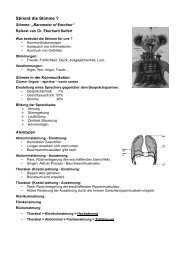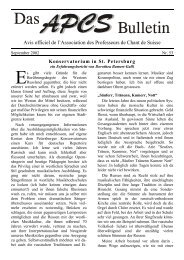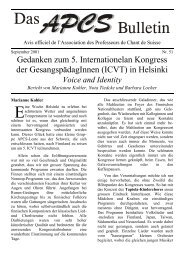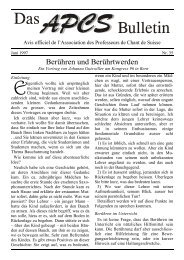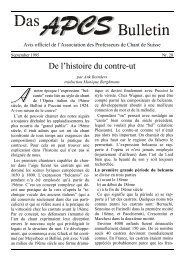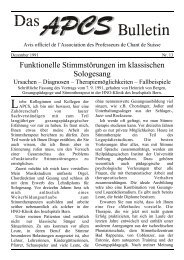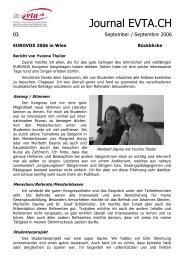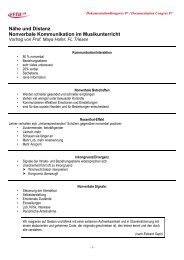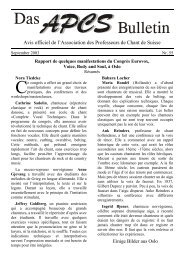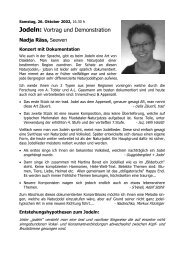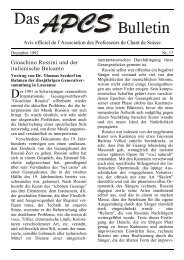Si canta come si parla? - Evta.ch
Si canta come si parla? - Evta.ch
Si canta come si parla? - Evta.ch
Create successful ePaper yourself
Turn your PDF publications into a flip-book with our unique Google optimized e-Paper software.
Avis officiel de l’Association des Professeurs de Chant de Suisse<br />
März 1997 Nr. 34<br />
<strong>Si</strong> <strong>canta</strong> <strong>come</strong> <strong>si</strong> <strong>parla</strong>?<br />
Von Prof. Ri<strong>ch</strong>ard Miller<br />
Na<strong>ch</strong>druck aus “The NATS Journal” März 1987 mit Erlaubnis des Autors<br />
<strong>Si</strong> <strong>canta</strong> <strong>come</strong> <strong>si</strong> <strong>parla</strong> (“one <strong>si</strong>ngs as<br />
one speaks”) is a familiar adage<br />
from the historic Italian S<strong>ch</strong>ool, the<br />
s<strong>ch</strong>ool that for several centuries dominated<br />
all serious vocalism in the Western world.<br />
Can it really be true that one <strong>si</strong>ngs as one<br />
speaks? A con<strong>si</strong>dered answer to that question<br />
might well be, “It depends on whi<strong>ch</strong><br />
language one is <strong>si</strong>nging, how clearly one<br />
enunciates it, and in what part of the vocal<br />
range one is <strong>si</strong>nging.”<br />
The <strong>si</strong>nging voice does not exist independent<br />
of the spee<strong>ch</strong> me<strong>ch</strong>anism. Problems<br />
of the <strong>si</strong>nging voice frequently are<br />
directly attributable to poor spee<strong>ch</strong> production.<br />
A <strong>si</strong>nger may suffer more fatigue from<br />
improper spee<strong>ch</strong> habits than from an inadequate<br />
<strong>si</strong>nging te<strong>ch</strong>nique. Yet people who<br />
learn to use the speaking voice well may<br />
nevertheless <strong>si</strong>ng badly. It surprises some<br />
listeners that a “resonant” speaker may not<br />
have an equally resonant quality in the <strong>si</strong>nging<br />
voice.<br />
Most speaking ranges encompass less<br />
than half the fully developed <strong>si</strong>nging range.<br />
Many pit<strong>ch</strong>es routinely used in <strong>si</strong>nging cannot<br />
pos<strong>si</strong>bly be delivered in spee<strong>ch</strong>. Then<br />
how does <strong>si</strong> <strong>canta</strong> <strong>come</strong> <strong>si</strong> <strong>parla</strong> have validity<br />
as a pedagogical tenet in the cultivated<br />
<strong>si</strong>nging voice?<br />
The acoustic theory of spee<strong>ch</strong> production<br />
and linguistic recognition is in large part<br />
based upon the assumption that vowel definition<br />
results from proper correspondence<br />
between laryngeal configuration and the filtering<br />
processes of resonator adjustment<br />
above the larynx. If vowel definition, as<br />
identified by specific phonetic postures, is<br />
displayed, “vowel tracking” of the<br />
laryngeally produced sound must take place<br />
within the resonator tract. In accomplishing<br />
su<strong>ch</strong> “acoustic tracking” of the vowel, the<br />
phy<strong>si</strong>cal and acoustic principles that contribute<br />
to ideal spee<strong>ch</strong> intelligibility must<br />
also be present in <strong>si</strong>nging. In this regard, <strong>si</strong><br />
<strong>canta</strong> <strong>come</strong> <strong>si</strong> <strong>parla</strong>.<br />
A very real problem exists for the <strong>si</strong>nger,<br />
in that the distinct phy<strong>si</strong>cal po<strong>si</strong>tions for<br />
phonemes described by the phonetician are<br />
not uniformly present in most spoken language.<br />
Further, the variety of vowels in su<strong>ch</strong><br />
languages as English, Fren<strong>ch</strong>, and German<br />
far exceed the seven vowels found in Italian:<br />
[i e ε α o u]. In languages with numerous<br />
vowel variations and with a high rate of<br />
diphthongization, the precise vowel<br />
postures identified in the phonetic books<br />
scarcely exist in practice: tran<strong>si</strong>tion sounds<br />
– on-glides and off-glides – are <strong>ch</strong>aracteristic<br />
of spee<strong>ch</strong>.
2<br />
In <strong>si</strong>nging, in contrast, because of the duration<br />
factor, phonetic preci<strong>si</strong>on in vowel<br />
definition is attainable in any language.<br />
Su<strong>ch</strong> phy<strong>si</strong>ological and acoustical exactitude<br />
underlies the rubric <strong>si</strong> <strong>canta</strong> <strong>come</strong> <strong>si</strong><br />
<strong>parla</strong>.<br />
There are, however, attitudes toward <strong>si</strong>nging<br />
te<strong>ch</strong>nique based upon the conviction<br />
that the <strong>si</strong>nging instrument is independent<br />
of the speaking instrument; elaborate systems<br />
have been erected that actually avoid<br />
spee<strong>ch</strong>-like coordinations in favor of<br />
“learned” laryngeal and vocal tract po<strong>si</strong>tioning<br />
for <strong>si</strong>nging. In these te<strong>ch</strong>niques, the<br />
<strong>si</strong>nger practices avoidance of the flexible<br />
postures of spee<strong>ch</strong> in favor of a pre-set<br />
“ideal” form of resonator coupling. Of<br />
course, if the <strong>si</strong>nger has been taught that the<br />
voice is best produced in a set mold of the<br />
mouth regardless of the vowel or the pit<strong>ch</strong><br />
to be sung, the relationship between larynx<br />
and vocal tract during a series of vowels will<br />
be drastically altered. In any case, if the<br />
conviction is that one ideal po<strong>si</strong>tion for <strong>si</strong>nging<br />
must be established, whether through a<br />
lateral [i] (“ee”) buccal posture as in the<br />
smile, or by an exaggerated [α] (“ah”) posture,<br />
as with the exces<strong>si</strong>vely lowered mandible,<br />
or with the rounded [ ] (“aw”) shape,<br />
acoustic imbalances will exist between the<br />
laryngeally generated sound and the vocaltract<br />
filtering system during any sequence<br />
of vowel sounds. In su<strong>ch</strong> theories of voice<br />
production, the notion that <strong>si</strong> <strong>canta</strong> <strong>come</strong> <strong>si</strong><br />
<strong>parla</strong> is patently rejected.<br />
To some extent, historical s<strong>ch</strong>ools of <strong>si</strong>nging<br />
can be described by their varying attitudes<br />
toward the functional relationships<br />
between the speaking and <strong>si</strong>nging voices.<br />
Even the <strong>ch</strong>oice of vowels for vocalization<br />
purposes (the preference for back as opposed<br />
to front vowels, or the reverse, or the<br />
predilection for the “mixed vowel” sounds)<br />
may be traced to the presence or absence of<br />
complex vowel formations in the language,<br />
as well as to aesthetic orientations toward<br />
certain vocal colorations. These partialities<br />
are most telling in the extreme ranges, both<br />
upper and lower, of the <strong>si</strong>nging voice.<br />
It is doubtful that tea<strong>ch</strong>ers in the historic<br />
international s<strong>ch</strong>ool ever looked for identical<br />
postures between sung and spoken<br />
vowel formations in any range of the voice.<br />
Rigid adherence to imitative buccal opening<br />
experienced in the speaking voice was probably<br />
never the intent of the admonition “to<br />
<strong>si</strong>ng as one speaks.” Assuredly, however,<br />
the distended perpendicular posture of the<br />
mouth, or the rounded “pout” of the lips<br />
seen in some current te<strong>ch</strong>niques of <strong>si</strong>nging<br />
cannot be in agreement with the older tenet,<br />
nor with what is known about the acoustic<br />
process of voiced communication. Raccogliere<br />
la bocca (“collect the mouth”) is a<br />
concept closely related to <strong>si</strong> <strong>canta</strong> <strong>come</strong> <strong>si</strong><br />
<strong>parla</strong>, and was expressly intended as a counterbalance<br />
to too mu<strong>ch</strong> vertical jaw and<br />
mouth action, and does not refer to some<br />
general protru<strong>si</strong>on of the lips throughout the<br />
vowel series.<br />
In the sequence of vowels, from the front<br />
through the neutral to the back vowels and<br />
their neighbors, the buccal cavity progresses<br />
from lateral through perpendicular<br />
to rounded postures, with the mouth being<br />
most opened on the [α] (“ah”). As the level<br />
of breath energy increases, and as pit<strong>ch</strong> and<br />
volume rise in the speaking voice, the mouth<br />
will open farther. In both spee<strong>ch</strong> and <strong>si</strong>nging,<br />
as the scale mounts the mouth tends to<br />
open wider, although the relative relationships<br />
among the vowels remain. This process<br />
is a major device for a<strong>ch</strong>ieving de<strong>si</strong>rable<br />
“vowel modification” in the upper<br />
register of the <strong>si</strong>nging voice and for producing<br />
the even scale.
<strong>Si</strong>nging in the upper extremes of the voice<br />
will entail the same increase in buccal opening<br />
as will other forms of heightened voiced<br />
expres<strong>si</strong>on, for example, laughter or calling.<br />
However, to maintain in the middle and<br />
lower <strong>si</strong>nging ranges the same open mouth<br />
po<strong>si</strong>tion whi<strong>ch</strong> is appropriate to the upper<br />
range has no more purpose than su<strong>ch</strong> a<br />
posture would have in the low range of the<br />
speaking voice. (In <strong>si</strong>nging the very lowest<br />
pit<strong>ch</strong>es that lie below the normal spee<strong>ch</strong>-inflection<br />
range, additional buccal opening<br />
may be de<strong>si</strong>rable.) Uniform vocal timbre<br />
throughout the scale is not a<strong>ch</strong>ieved by<br />
maintaining one buccal posture – or something<br />
close to it – because vowel definition<br />
results from acoustic po<strong>si</strong>tions that alter<br />
with <strong>ch</strong>anging vowel shapes, pit<strong>ch</strong> and dynamic<br />
levels. Any “unification” of the vocal<br />
scale that avoids flexibility of vowel definition<br />
causes a common quality of distortion.<br />
If, as so often is the case, a <strong>si</strong>nger experiences<br />
jaw ten<strong>si</strong>on because of a set mouth<br />
posture – generally with the jaw dropped too<br />
far – momentarily lightly shifting the jaw in<br />
quick, brief lateral or circular movements<br />
will release the jaw from the fixed po<strong>si</strong>tion.<br />
(Su<strong>ch</strong> lateral or circular movements are not<br />
continued during spee<strong>ch</strong> or <strong>si</strong>nging, of<br />
course.)<br />
To a large extent, then, the old adage <strong>si</strong><br />
<strong>canta</strong> <strong>come</strong> <strong>si</strong> <strong>parla</strong> is firmly based upon<br />
subsequent phonetic findings of the scientific<br />
age, with regard to acoustic factors. Of<br />
course that advice is not in oppo<strong>si</strong>tion to the<br />
equally strong dictum “portare la voce”<br />
(“carry the voice”) upon whi<strong>ch</strong> the essential<br />
art of legato is premised. In a language free<br />
of diphthongization and without percus<strong>si</strong>ve<br />
inflection, as is the case with Italian, the two<br />
historic concepts (“<strong>si</strong>ng as you speak / carry<br />
the voice”) are not inimical. Indeed, legato<br />
<strong>si</strong>nging is pos<strong>si</strong>ble only when the enuncia-<br />
tory principle is economically realized (as<br />
in raccogliere la bocca).<br />
It is pos<strong>si</strong>ble to <strong>si</strong>ng the many sounds of<br />
any language with the same phonetic principles<br />
by whi<strong>ch</strong> the Italian language can be<br />
managed. The high incidence of consonant<br />
clustering in some languages, specifically<br />
German, English and some Eastern European<br />
languages, need not interfere with<br />
good vowel definition so long as tran<strong>si</strong>tion<br />
sounds stemming from those consonantal<br />
events are avoided. (Good <strong>si</strong>ngers have already<br />
learned to eliminate regional spee<strong>ch</strong><br />
habits in <strong>si</strong>nging.) Most tran<strong>si</strong>tion sound is<br />
caused by inappropriate attempts to return<br />
to a distended mouth posture when the<br />
vowel and the pit<strong>ch</strong> in question do not tolerate<br />
that kind of motion. Clarity of timbre,<br />
clean diction, and legato line are then inevitably<br />
disturbed.<br />
<strong>Si</strong> <strong>canta</strong> <strong>come</strong> <strong>si</strong> <strong>parla</strong> continues to have<br />
important contemporary pedagogical application.<br />
The maxim stands in direct opposetion<br />
to te<strong>ch</strong>niques that endorse either exces<strong>si</strong>vely<br />
me<strong>ch</strong>anistic or mi<strong>si</strong>nformed<br />
approa<strong>ch</strong>es to resonator adjustment for the<br />
<strong>si</strong>nging voice. ■<br />
Rhythmus ist das einzige, was<br />
mu<strong>si</strong>kalis<strong>ch</strong> ni<strong>ch</strong>t gebildete Ohren<br />
in einem Tonstück fühlen und<br />
begreifen können.<br />
3<br />
Johann Nikolaus Forkel



